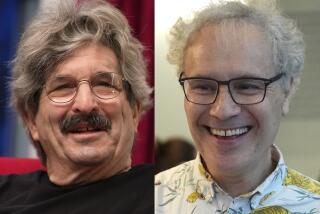3 Who Rigged a Chemical Toss of the Coin Share Nobel Prize
Two Americans--one at the Scripps Research Institute in La Jolla--and a Japanese have won the 2001 Nobel Prize in chemistry for discovering ways to synthesize useful chemical compounds without producing their sometimes dangerous mirror images.
K. Barry Sharpless of Scripps will receive half of the $943,000 award, while William S. Knowles of St. Louis and Ryoji Noyori of Nagoya University will split the other half.
Most natural molecules can exist in mirror-image forms, like gloves for the right and left hands. But nature is left-handed. The right-handed version of molecules is generally worthless and sometimes dangerous.
A prime example of the difference involves the drug thalidomide, used in the 1960s by pregnant women to control nausea and now employed as a cancer drug. One three-dimensional form of the drug is effective for controlling nausea; the mirror-image form causes birth defects. In the 1960s, the drug was sold as a mixture of the two forms, leading to a medical catastrophe.
Another, simpler example is the flavoring chemical limonene. One form smells like lemons; its mirror-image smells like oranges.
Normal synthetic reactions produce an equal mixture of both forms of such chemicals. Producing only one version requires controlling the three-dimensional structure of molecules. The new Nobel laureates devised catalysts that would direct the synthesis so only one form results. Their work sowed the seeds for what is now a $133-billion industry for what are called chiral drugs.
“To specifically produce these forms is a major achievement” that was sought for decades, said USC chemist George Olah, a Nobel chemistry winner in 1994. “They developed very clever ways to produce only the right forms.”
Dr. Marvin Cassman, director of the National Institute of General Medical Sciences, which funded much of Sharpless’ work, likened the results to being able to take “the random part out of the coin toss so that the quarter always comes up heads.”
Knowles, 84 and retired, made his breakthrough in 1968 when he was employed by Monsanto Co. in St. Louis. He devised a way to produce levodopa, a drug widely used to treat Parkinson’s disease, without producing its mirror image.
“This was the first time this kind of thing had been done,” said Knowles, who has been retired since 1986. “Several others tried, and we just happened to win that race. We got there first.”
As for the Nobel, “I never even conceived that this was possible--especially after all these years.”
Knowles is no longer actively involved in research, spending his winters in St. Louis and his summers in Jackson, Wyo. He is an avid fly fisherman and plans to donate most of his share of the award to research.
The specific feat Knowles achieved was to add a hydrogen molecule to a double-bond between two carbon molecules. Noyori, 63, expanded on this achievement by developing other, more powerful catalysts to do the same thing.
His work led to the industrial synthesis of several antibiotics, chemicals such as menthol, and other products.
“Looking back [to] the time I started my research--when this country was still poor--I have come a very long way,” Noyori said at a news conference in Japan. “At that difficult time, I discovered a bud and I have since kept nurturing it.”
Noyori added that “the Nobel prize is the greatest honor for one studying the natural sciences and I cannot be any more honored.”
Sharpless, 60, made his discovery 12 years after Knowles. The feat was to add oxygen molecules to a double bond in such a way as to form only one mirror-image molecule. The addition of an oxygen atom opens the door to a wide variety of other synthetic procedures, and Sharpless’ feat was characterized by the Nobel committee as “the most important discovery in the field of synthesis during the past few decades.”
While working at Stanford University in 1980 with Tsutomo Katsuki, now at Kyushu University in Japan, Sharpless had a “eureka moment” in which he combined titanium from white paint and tartaric acid from wine as a catalyst to carry out the oxidation reaction.
Instead of getting a 50-50 mix of chemicals, Sharpless was able to produce nearly 100% of one mirror image.
The first application was in the production of a commercially important sex lure for gypsy moths. More important in the long term was its use to produce glycidol, a key raw material in manufacturing a family of heart drugs called beta-blockers. The technique has been adapted to many other synthetic procedures as well.
Sharpless has long been expected to receive the Nobel for his efforts. “I’ve been teased for 20 years about this,” he noted.
Not anticipating the normal early-morning announcement of the prize, Sharpless and his wife, Janet, had not gone to bed until 1 a.m. Wednesday morning. Following their usual practice, they did not answer the phone after retiring. When he was finally roused by a colleague at 4 a.m. with the news, there were already 18 telephone messages waiting.
Growing up in Philadelphia, Sharpless was encouraged by his father, a surgeon, to become a physician. He began a medical program at Dartmouth, but a professor encouraged him to take a year off to try research at Stanford. He never returned.
“I just thought that being a doctor was hard work,” he said. “You never seemed to sleep. But I’m not sure, if you’re driven, that being a chemist is much easier.”
*
Times science writer Robert Lee Hotz contributed to this report.
More to Read
Sign up for Essential California
The most important California stories and recommendations in your inbox every morning.
You may occasionally receive promotional content from the Los Angeles Times.










